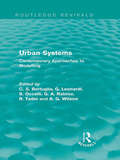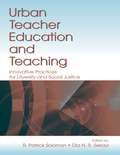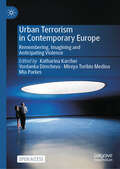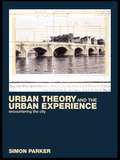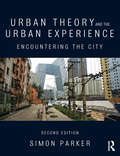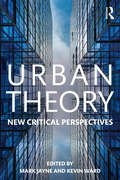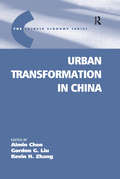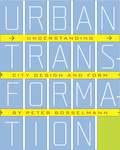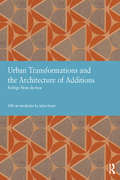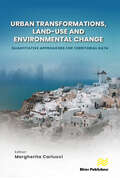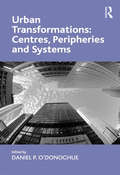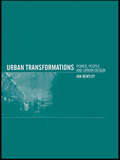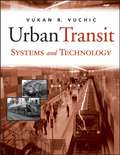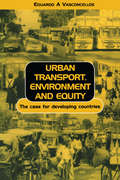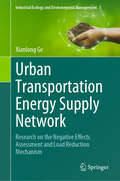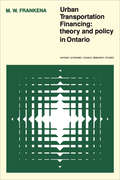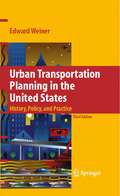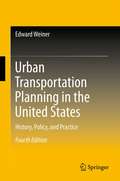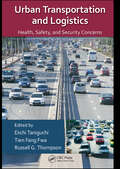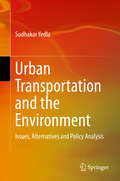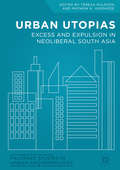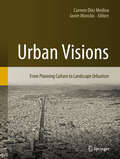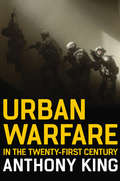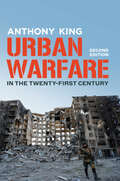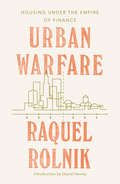- Table View
- List View
Urban Systems: Contemporary Approaches to Modelling (Routledge Revivals #Vol. 1)
by C. S. Bertuglia A. G. Wilson G. Leonardi S. Occelli G. A. Rabino R. TadeiThis edited collection, first published in 1987, provides a comparative analysis of different approaches to urban modelling, and lays the foundations for the possibility of integration and a more unified field. The first part contextualises the development of the field of urban systems modelling, focusing on the variety of approaches and possible implications of this on the future of research and methodology. Next, the editors consider economic and ‘non-economic’ approaches, followed by an analysis of spatial-interaction-based approaches. Providing an overview to the field and research literature, the overarching argument is that there should be an integrated methodological approach to urban system modelling.
Urban Teacher Education and Teaching: Innovative Practices for Diversity and Social Justice
by R. Patrick SolomonThis volume illuminates the most pressing challenges faced by urban schools, teachers, teacher candidates, and teacher training programs and offers a range of insights and possibilities for urban teacher education and teaching. Covering issues spanning the broadly theoretical to the urgently practical, it goes beyond the traditional discourses in teacher education to focus on diversity, social justice, democratic schooling, and community building. What emerges is an emphatic message of hope for those committed to the ongoing project of improving urban teacher education and working in urban settings. Contributors from Canada, the United States, and the Caribbean bring rich and divergent knowledges, perspectives, and cultural experiences to their discussion of the three central themes around which the book is organized:• the conceptual framing of key issues in urban schooling;• pre-service teacher preparation for urban transformation; and • culturally relevant pedagogy and advocacy in urban settings. This book is intended for all students, practitioners, and researchers involved in urban education. It is appropriate as a text for student teaching and field experience seminars, and for courses dealing with social issues, educational policy, curriculum development, and multicultural teacher education.
Urban Terrorism in Contemporary Europe: Remembering, Imagining and Anticipating Violence
by Katharina Karcher Yordanka Dimcheva Mireya Toribio Medina Mia ParkesThis open access book sheds light on collective practices of remembering, imagining and anticipating in relation to recent acts of urban terrorism in Europe. Analysing a range of personal and collective responses to urban terrorism in contemporary Europe, this book shows that current debates on this issue are shaped by multiple co-existing and intersecting memories of political violence in the past. Moreover, despite public declarations of unity and solidarity, collective memories of urban terror in contemporary Europe are far from consensual - memory can be both a catalyst for and an impediment to social and political change. Drawing on case studies from a range of European countries and creative responses by survivors, artists, and poets, this interdisciplinary volume introduces readers to key methods (e.g. discourse analysis and (auto-)ethnography) and concepts (e.g. Lieux de Mémoire and ‘grassroots memorials’) for the study of the memoralization of terror attacks.
Urban Theory and the Urban Experience: Encountering the City
by Simon ParkerFor the first time Urban Theory and the Urban Experience brings together classic and contemporary approaches to urban research in order to reveal the intellectual origins of urban studies, and the often unacknowledged debt that empirical and theoretical perspectives on the city owe to one another. Both students and urban scholars will appreciate the critical way in which classical and contemporary debates on the nature of the city are presented. Extensive use is made throughout of documentary, literary and cultural sources to bring the different theoretical perspectives to life. Discussion points introduce and explain key concepts and intellectual histories in a jargon free manner. End of chapter further readings have also been annotated to encourage additional study.
Urban Theory and the Urban Experience: Encountering the City
by Simon ParkerUrban Theory and the Urban Experience brings together classic and contemporary approaches to urban research in order to reveal the intellectual origins of urban studies and the often unacknowledged debt that empirical and theoretical perspectives on the city owe one another. From the foundations of modern urban theory in the work of Weber, Simmel, Benjamin and Lefebbvre to the writings of contemporary urban theorists such as David Harvey and Manuel Castells and the Los Angeles school of urbanism, Urban Theory and the Urban Experience traces the key developments in the idea of the city over more than a century. Individual chapters explore investigative studies of the great metropolis from Charles Booth to the contemporary urban research of William J. Wilson, along with alternative approaches to the industrial city, ranging from the Garden City Movement to ‘the new urbanism’. The volume also considers the impact of new information and communication technologies, and the growing trend towards disaggregated urban networks, all of which raise important questions about viability and physical and social identity of the conventional townscape. Urban Theory and the Urban Experience concludes with a rallying cry for a more holistic and integrated approach to the urban question in theory and in practice if the rich potent. For the benefit of students and tutors, frequent question points encourage exploration of key themes, and annotated further readings provide follow-up sources for the issues raised in each chapter. The book will be of interest to students, scholars, practitioners and all those who wish to learn more about why the urban has become the dominant social, economic and cultural form of the twenty-first century
Urban Theory: New critical perspectives
by Kevin Ward Mark JayneUrban Theory: New Critical Perspectives provides an introduction to innovative critical contributions to the field of urban studies. Chapters offer easily accessible and digestible reviews, and as a reference text Urban Theory is a comprehensive and integrated primer which covers topics necessary for a full understanding of recent theoretical engagements with cities. The introduction outlines the development of urban theory over the past two hundred years and discusses significant theoretical, methodological and empirical challenges facing the field of urban studies in the context of an increasing globally inter-connected world. The chapters explore twenty-four topics, which are new additions to the urban theoretical debate, highlighting their relationship to long established concerns that continue to have intellectual purchase, and which also engage with rich new and emerging avenues for debate. Each chapter considers the genealogy of the topic at hand and also includes case studies which explain key terms or provide empirical examples to guide the reader to a better understanding of how theory adds to our understanding of the complexities of urban life. This book offers a critical and assessable introduction to original and groundbreaking urban theory and will be essential reading for undergraduate and postgraduate students in human geography, sociology, anthropology, cultural studies, economics, planning, political science and urban studies.
Urban Transformation in China (The Chinese Trade and Industry Series)
by Gordon G. LiuThis book provides a general description and evaluation of the process of urbanization in China and the urgent challenges facing the Chinese government. Urban Transformation in China examines the changing pattern of China's urban population and the determinants of these changes, including an analysis of the spatial structures of China's cities and industry and an assessment of urban productivity growth and the role of mega cities in national development. The book's coverage encompasses both academic and policy perspectives. With its sister volume Urbanization and Social Welfare in China it provides a comprehensive and multidisciplinary overview of the country’s urbanization process.
Urban Transformation: Understanding City Form and Design
by Peter BosselmannHow do cities transform over time? And why do some cities change for the better while others deteriorate? In articulating new ways of viewing urban areas and how they develop over time, Peter Bosselmann offers a stimulating guidebook for students and professionals engaged in urban design, planning, and architecture. By looking through Bosselmann's eyes (aided by his analysis of numerous color photos and illustrations) readers will learn to "see" cities anew. Bosselmann organizes the book around seven "activities": comparing, observing, transforming, measuring, defining, modeling, and interpreting. He introduces readers to his way of seeing by comparing satellite-produced "maps" of the world's twenty largest cities. With Bosselmann's guidance, we begin to understand the key elements of urban design. Using Copenhagen, Denmark, as an example, he teaches us to observe without prejudice or bias. He demonstrates how cities transform by introducing the idea of "urban morphology" through an examination of more than a century of transformations in downtown Oakland, California. We learn how to measure quality-of-life parameters that are often considered immeasurable, including "vitality," "livability," and "belonging." Utilizing the street grids of San Francisco as examples, Bosselmann explains how to define urban spaces. Modeling, he reveals, is not so much about creating models as it is about bringing others into public, democratic discussions. Finally, we find out how to interpret essential aspects of "life and place" by evaluating aerial images of the San Francisco Bay Area taken in 1962 and those taken forty-three years later. Bosselmann has a unique understanding of cities and how they "work." His hope is that, with the fresh vision he offers, readers will be empowered to offer inventive new solutions to familiar urban problems.
Urban Transformations and the Architecture of Additions (Studies in International Planning History)
by Rodrigo Perez de ArceRodrigo Perez de Arce's essay Urban Transformations and Architectural Additions was published during the formative stages of Post Modernism, at the point where theory was becoming seriously established. Jencks' first essays formalising the term Post Modernism in architecture and the revised Learning from Las Vegas were published the previous year. In planning terms, modernism had become associated with comprehensive redevelopment and forms of urban organisation that ignored context, history and any sense of tradition. De Arce considered the essential nature of buildings and the richness of historic urban form and explored how robust that essence was over time. He looked at the value of essential remnants and rich complexities in maintaining a sense of continuity and relevance. Having explored the adaptation process in history, de Arce went on to see how such a process might be simulated in contemporary cities with modern buildings, using additions and layers to change them from objects in infinite windswept space to being part of a rich urban fabric which described urban place. To do this he used concrete examples; housing schemes by James Stirling, new government centres in Chandigrah and Dacca and more prosaic 60's housing blocks. The paper had a fundamental influence on the way that architects and planners thought about the nature of cities: as dynamic organisms that were tangible to human beings, completely opposite to the systems thinking of the time. It contributed to ideas about the importance of street, place and city block which influenced so much recent regeneration practice. As we enter a phase of development where the reuse and adaptation of existing buildings is becoming paramount from both an economic and sustainable point of view, Perez de Arce's paper gives important insights into how to think about the process positively.
Urban Transformations, Land-use, and Environmental Change: Quantitative Approaches for Territorial Data
by Margherita CarlucciThis book provides interesting insights for the identification of socioeconomic, demographic and territorial factors that affect structural disparities in local economies. Urban development is the result of demographic dynamics at the local level, connected to socioeconomic factors, and of economic growth, whose fluctuations are particularly sensitive to the economic cycle in countries, such as the ones in the Mediterranean basin, characterized by greater informality of the sector and limited public/social housing. Our objective is to provide a contribution to sustainability planning, explaining the linkage between forms of urban development and economic growth, providing policy indications for integrated spatial planning, and for cohesion policies that may leverage social and economic competitiveness.
Urban Transformations: Centres Peripheries And Systems
by Daniel O'DonoghueDefinitions of urban entities and urban typologies are changing constantly to reflect the growing physical extent of cities and their hinterlands. These include suburbs, sprawl, edge cities, gated communities, conurbations and networks of places and such transformations cause conflict between central and peripheral areas at a range of spatial scales. This book explores the role of cities, their influence and the transformations they have undertaken in the recent past. Ways in which cities regenerate, how plans change, how they are governed and how they react to the economic realities of the day are all explored. Concepts such as polycentricity are explored to highlight the fact that cities are part of wider regions and the study of urban geography in the future needs to be cognisant of changing relationships within and between cities. Bringing together studies from around the world at different scales, from small town to megacity, this volume captures a snapshot of some of the changes in city centres, suburbs, and the wider urban region. In doing so, it provides a deeper understanding of the evolving form and function of cities and their associated peripheral regions as well as their impact on modern twenty-first century landscapes.
Urban Transformations: Power, People and Urban Design
by Ian BentleyCities affect every person's life, yet across the traditional divides of class, age, gender and political affiliation, armies of people are united in their dislike of the transformations that cities have undergone in recent times. The physical form of the urban environment is not a designer add-on to 'real' social issues; it is a central aspect of the social world. Yet in many people's experience, the cumulative impacts of recent urban development have created widely un-loved urban places. To work towards better-loved urban environments, we need to understand how current problems have arisen and identify practical action to address them.Urban Transformations examines the crucial issues relating to how cities are formed, how people use these urban environments and how cities can be transformed into better places. Exploring the links between the concrete physicality of the built environment and the complex social, economic, political and cultural processes through which the physical urban form is produced and consumed, Ian Bentley proposes a framework of ideas to provoke and develop current debate and new forms of practice.
Urban Transit Systems And Technology
by Vukan VuchicThis is the only current and in print book covering the full field of transit systems and technology. Beginning with a history of transit and its role in urban development, the book proceeds to define relevant terms and concepts, and then present detailed coverage of all urban transit modes and the most efficient system designs for each. Including coverage of such integral subjects as travel time, vehicle propulsion, system integration, fully supported with equations and analytical methods, this book is the primary resource for students of transit as well as those professionals who design and operate these key pieces of urban infrastructure.
Urban Transport Environment and Equity: The Case for Developing Countries
by Eduardo Alcantara VasconcellosTraditional transport planning has generated transport systems that propagate an unfair distribution of accessibility and have environmental and safety issues. This book highlights the importance of social and political aspects of transport policy and provides a methodology to support this approach. It emphasizes the importance of co-ordinating urban, transport and traffic planning, and addresses the major challenge of modifying the building and use of roads. The author makes suggestions for innovative and radical new measures towards an equitable and sustainable urban environment.
Urban Transportation Energy Supply Network: Research on the Negative Effects Assessment and Load Reduction Mechanism (Industrial Ecology and Environmental Management #5)
by Xianlong GeThis book conducts research on the evaluation and reduction mechanism of the negative effects of urban Transportation Energy Supply Network (TESN). By analyzing the current supply and demand situation of urban transportation energy supply network, the concept of negative effects of urban transportation energy supply network is defined, and specific definitions and measurement methods of negative effects are proposed. A TESN negative effect reduction mechanism was constructed from three aspects: site layout optimization, site cooperation game, and replenishment vehicle scheduling. The simulation validation of the urban transportation energy supply network was conducted using AnyLogic simulation software.
Urban Transportation Financing: Theory and Policy in Ontario
by Mark W. FrankenaThis is an economic analysis of pricing and subsidy policies for urban roads and urban public transit in Ontario. Professor Frankena demonstrates the benefits of evaluating the economic merits of policy alternatives, and attempts to determine whether existing policies waste resources or lead to undesirable income transfers among different groups in the population. He concludes that resources are being wasted because the use of urban roads is substantially underpriced during periods of peak demand. He also finds that while there are sound economic justifications for substantial public transit subsidies, the allocation of subsidies by the Ontario government on the basis of capital expenditures can be expected to waste resources, as can the maximization of ridership which is likely to lead to detrimental fare and service policies. In conclusion, Frankena suggests improvements in the systems for charging people for the use of roads and public transit and in the ways that governments provide subsidies.
Urban Transportation Planning in the United States: History, Policy, and Practice, 3rd Edition
by Edward WeinerThe development of U.S. urban transportation policy over the past 50 years illustrates the changing relationships among federal, state, and local governments. This comprehensive text examines the evolution of urban transportation planning from early developments in highway planning in the 1930s to today's concerns over sustainable development, security, and pollution control. Focusing on major national events, the book discusses the influence of legislation, regulations, conferences, federal programs, and advances in planning procedures and technology. The book focuses in-depth at the most significant event in transportation planning--the Federal-Aid Highway Act of 1962; creating a federal mandate for a comprehensive urban transportation planning process carried out cooperatively by states and local governments with federal funding, this act was crucial in the spread of urban transportation. Claiming that urban transportation planning is more sophisticated, costly, and complex than its highway and transit planning predecessors, the book demonstrates how urban transportation planning evolved in response to changes in such factors as environment, energy, development patterns, intergovernmental coordination, and federal transit programs. It further illustrates how broader concerns for global climate change and sustainable development have braided the purview of transportation planning. This fully updated, revised, and expanded edition highlights the dynamics of transportation planning post-9/11, covers the impact of recent legislation, emphasizes such timely issues as security, oil dependence, performance measurement, and public-private sector collaboration.
Urban Transportation Planning in the United States: History, Policy, and Practice, 4th Edition
by Edward WeinerThe development of U.S. urban transportation policy over the past 50 years illustrates the changing relationships among federal, state, and local governments. This comprehensive text examines the evolution of urban transportation planning from early developments in highway planning in the 1930s to today's concerns over sustainable development, security, and pollution control. Focusing on major national events, the book discusses the influence of legislation, regulations, conferences, federal programs, and advances in planning procedures and technology. The book focuses in-depth at the most significant event in transportation planning--the Federal-Aid Highway Act of 1962; creating a federal mandate for a comprehensive urban transportation planning process carried out cooperatively by states and local governments with federal funding, this act was crucial in the spread of urban transportation. Claiming that urban transportation planning is more sophisticated, costly, and complex than its highway and transit planning predecessors, the book demonstrates how urban transportation planning evolved in response to changes in such factors as environment, energy, development patterns, intergovernmental coordination, and federal transit programs. It further illustrates how broader concerns for global climate change and sustainable development have braided the purview of transportation planning. This fully updated, revised, and expanded edition highlights the dynamics of transportation planning post-9/11, covers the impact of recent legislation, emphasizes such timely issues as security, oil dependence, performance measurement, and public-private sector collaboration.
Urban Transportation and Logistics: Health, Safety, and Security Concerns
by Eiichi Taniguchi Russell G. Thompson Tien Fang FwaAlthough society has become increasingly dependent on the timely operation of logistics systems, we still face many problems regarding efficiency, the environment, energy consumption, and safety in urban transport and logistics under normal cases and in disasters. As such, understanding how to address these challenges has become essential for creat
Urban Transportation and the Environment
by Sudhakar YedlaThe book deals with urban transportation planning in light of environmental sustainability and social equity. It begins with a review of the Indian urban transportation system and the issues surrounding it, and discusses the alternatives and policy directions that are being considered. It examines all the environmental issues arising out of transportation as a sector and assesses the alternatives that can be considered to improve sustainability. Further, the book not only analyses transportation modes that cater to the travel needs of the poor, so as to make them more socially equitable, but also explores measures to promote them using a multi-criteria and multi-stakeholder approach. It addresses the barriers that are bottlenecks for the implementation of cleaner fuels and modes of transport and presents an incremental approach to tackle environmental concerns, including climate change, when planning transportation in the long term. Finally, it presents the dilemma of city administrators in choosing between strategies aimed at local pollution control and those aimed at limiting global emissions. This unique book provides a comprehensive overview of "sustainable transportation. " It discusses all the important elements that are essential to transportation planners and policy makers when planning a city's transportation. Theoretical presentations augmented by case-specific research work and the methodology used in some of the modules, make it a valuable resource for researchers working at the forefront of this area.
Urban Utopias
by Tereza Kuldova Mathew A. VargheseThis book brings anthropologists and critical theorists together in order to investigate utopian visions of the future in the neoliberal cities of India and Sri Lanka. Arguing for the priority of materiality in any analysis of contemporary ideology, the authors explore urban construction projects, special economic zones, fashion ramps, films, archeological excavations, and various queer spaces. In the process, they reveal how diverse co-existing utopian visions are entangled with local politics and global capital, and show how these utopian visions are at once driven by visions of excess and by increasing expulsions. It's a dystopia already in the making - one marred by land grabs and forced evictions, rising inequality, and the loss of urbanity and civility.
Urban Visions: From Planning Culture to Landscape Urbanism
by Carmen Díez Medina Javier MonclúsThis book is a useful reference in the field of urbanism. It explains how the contemporary city and landscape have been shaped by certain twentieth century visions that have carried over into the twenty-first century. Aimed at both students and professionals, this collection of essays on diverse subjects and cases does not attempt to establish universal interpretations; it rather highlights some outstanding episodes that help us understand why the planning culture has given way to other forms of urbanism, from urban design to strategic urbanism or landscape urbanism. Compared with global interpretations of urbanism based on socioeconomic history or architectural historiography, Urban Visions. From Planning Culture to Landscape Urbanism, aims to present the discipline couched in international contemporary debate and adopt a historic and comparative perspective. The book’s contents pertain equally to other related disciplines, such as architecture, urban history, urban design, landscape architecture and geography.Foreword by Rafael Moneo.
Urban Warfare in the Twenty-First Century
by Anthony KingWarfare has migrated into cities. From Mosul to Mumbai, Aleppo to Marawi, the major military battles of the twenty-first century have taken place in densely populated urban areas. Why has this happened? What are the defining characteristics of urban warfare today? What are its military and political implications? Leading sociologist Anthony King answers these critical questions through close analysis of recent urban battles and their historical antecedents. Exploring the changing typography and evolving tactics of the urban battlescape, he shows that although not all methods used in urban warfare are new, operations in cities today have become highly distinctive. Urban warfare has coalesced into gruelling micro-sieges, which extend from street level – and below – to the airspace high above the city, as combatants fight for individual buildings, streets and districts. At the same time, digitalized social media and information networks communicate these battles to global audiences across an urban archipelago, with these spectators often becoming active participants in the fight. A timely reminder of the costs and the horror of war and violence in cities, this book offers an invaluable interdisciplinary introduction to urban warfare in the new millennium for students of international security, urban studies and military science, as well as military professionals.
Urban Warfare in the Twenty-First Century
by Anthony KingWar is urbanising. From Mosul to Mumbai, Aleppo to Marawi, the largest and most intense battles of the twenty-first century have taken place in densely populated urban areas. In the Ukraine War, Russian and Ukrainian troops have converged on urban areas, Kyiv, Mariupol, and Bakhmut, to fight brutal attritional sieges. Meanwhile the Battle of Gaza rages. Through a close analysis of recent urban conflicts and their historical antecedents, sociologist Anthony King explores the changing typography of the urban battlescape. Whilst many tactics used in urban warfare are not new, he shows how operations in cities today have coalesced into localised micro-sieges, which extend from street level – and below – to the airspace high above the city, as combatants fight for individual buildings, streets and districts. At the same time, digitalized social media and information networks communicate these battles to global audiences across an urban archipelago, with these spectators often becoming active participants in the fight. Fully revised and updated to include detailed examples from Ukraine and Gaza to illustrate the anatomy of twenty-first century urban warfare, the second edition of this popular text is a timely reminder of the costs and the horror of war and violence in cities. As such, it offers an invaluable interdisciplinary introduction to urban warfare in the new millennium for students of international security, urban studies and military science, as well as military professionals.
Urban Warfare: Housing under the Empire of Finance
by Raquel RolnikHow finance and politics have caused the global housing crisisThe most comprehensive survey of the current crisis, Urban Warfare charts how the financial crisis and wider urban politics have left millions homeless and in financial desperation across the world.The financialisation of housing has become a global catastrophe, leaving millions desperate and homeless. Since the 2008 financial collapse, models of home ownership, originating in the US and UK, are being exported around the world. Using examples from across the globe, Rolnik shows how our cities have been sold to construction companies and banks, while supported by government-facilitated schemes, such as “the right to buy” subsidies and micro-financing. Our homes and neighbourhoods have become the “last subprime frontiers of capitalism,” organised by those who benefit the most.
